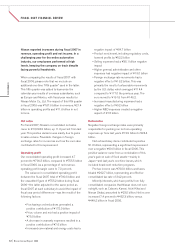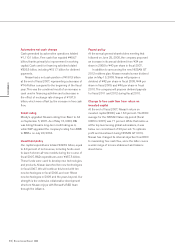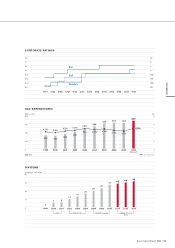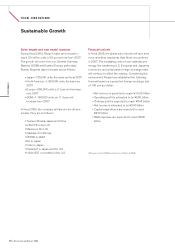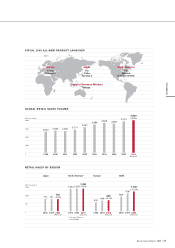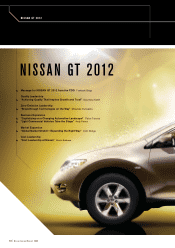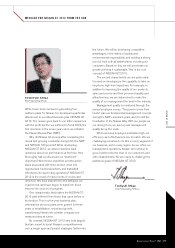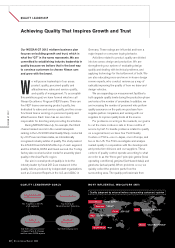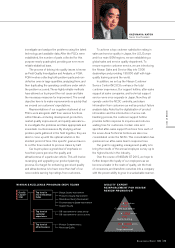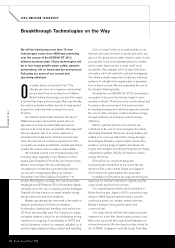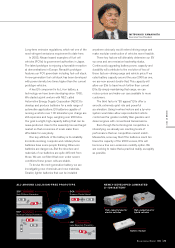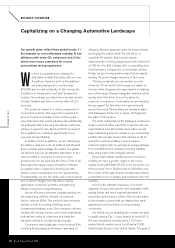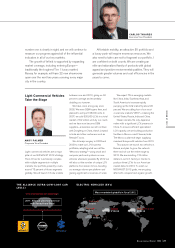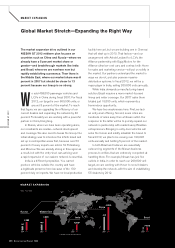Nissan 2008 Annual Report Download - page 24
Download and view the complete annual report
Please find page 24 of the 2008 Nissan annual report below. You can navigate through the pages in the report by either clicking on the pages listed below, or by using the keyword search tool below to find specific information within the annual report.
QUALITY LEADERSHIP GOALS MOST INFLUENTIAL INDICATORS (MII)
Perceived Quality
& Attractiveness
No. 1 position in 50+%
of all segments
Sales &
Service Quality
Top-level customer service
in Japan, the U.S., Europe
and four main GOM regions
Product Quality
Top level in all
“Most Influential” Indicators
Quality of
Management
Top-level industry norm
Quality judgment by external indices representing customer’s opinion
“WHAT CAR?”
Great Britain
“ADAC”
Germany
“QUATTRORUOTE”
Italy
“JDP IQS”
China “Consumer Reports”
U.S.
“PSI”
South Africa
“QUATRO RODAS”
Brazil
22 Nissan Annual Report 2008
NISSAN GT 2012
QUALITY LEADERSHIP
Achieving Quality That Inspires Growth and Trust
Our NISSAN GT 2012 midterm business plan
focuses on building growth and trust, which is
what the “GT” in the name represents. We are
committed to establishing industry leadership in
quality because we believe that is the best way
to convince customers to choose Nissan cars
and grow with the brand.
We will pursue leadership in four areas:
product quality, perceived quality and
attractiveness, sales and service quality,
and quality of management. To accomplish
this ambitious goal, we have formed what we call
Nissan Excellence Program (NEP) teams. There are
five NEP teams overseeing product quality, two
dedicated to sales and service quality, and two cross-
functional teams working on perceived quality and
attractiveness. Each team has an executive
responsible for directing and promoting its activities.
During NISSAN Value-Up, for example, the Infiniti
channel ranked second in the overall nameplate
ranking in the U.S. 2008 Initial Quality Study conducted
by J. D. Power and Associates, an internationally
recognized industry arbiter of quality. The study ranked
the Infiniti EX and Infiniti M at the top of each segment,
and the Infiniti G, QX56 and Quest second. Our Tochigi
factory also received a silver medal for assembly plant
quality in the Asia-Pacific region.
Our aim in overall product quality is to be the
industry leader by fiscal 2012, as measured in the
quality indices produced by independent organizations
such as Consumer Reports in the U.S. and ADAC in
Germany. These ratings are influential and have a
major impact on consumer buying behavior.
Activities related to product quality are divided
into two areas: design and production. We are
strengthening our system of evaluating design
quality and dealing with technical problems, and
applying technology for the betterment of both. We
are also educating more and more in-house design
review experts, who conduct reviews as a way of
radically improving the quality of how we draw and
design vehicles.
We are expanding our measurement facilities to
both upgrade quality levels during the production phase
and reduce the number of anomalies. In addition, we
are increasing the number of personnel who perform
quality assurance on the parts we purchase from
supplier-partner companies, and working with our
suppliers to improve quality levels at the source.
For problems occurring in the markets, our goal is
to cut the claim incidence rate in three months of
service by half. To handle problems related to quality
on a regional level, we have four Field Quality
Centers or FQCs—one in Japan, one in Europe, and
two in the U.S. The FQCs investigate and analyze
market quality in cooperation with the development
and production divisions and our suppliers. These
centers of quality control operate according to what
we refer to as the “three gen” principle: genba (local
operating conditions), genjitsu (fact-based data), and
genbutsu (actual parts). When problems occur, we
quickly collect the problem parts from the
surrounding area. The quality professionals then


